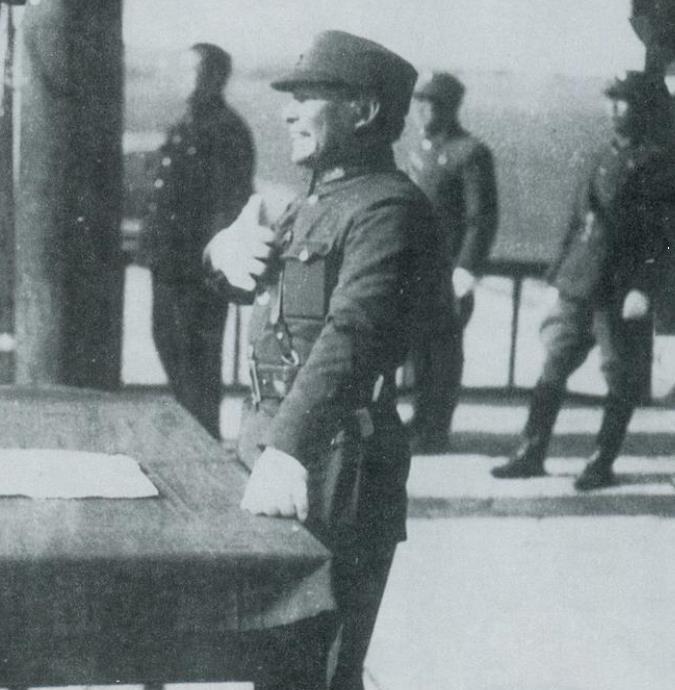
Hu Zongnan, alias Qinzhai (秦斋), was born in Xiapu Town, Zhenhai, and moved to Xiaofeng, Zhejiang Province, with his father and uncle. After graduating from high school, Hu Zongnan worked as a primary school teacher in Xiaofeng and later applied for the Whampoa Military Academy. Later, because of Chiang Kai-shek's weight, Hu Zongnan was promoted all the way to the commander of the First Theater, becoming a second-class general with hundreds of thousands of heavy troops and a famous "King of the Northwest". Let's take a look at a group of photos of Hu Zongnan. This photo is a lecture at the Hexi Grand Playground of the Seventh Branch of the Central Army Officer School founded by Hu Zongnan in Wang Qu, Chang'an County. The Seventh Branch is both the epitome of the Whampoa Military Academy and the epitome of Hu Zongnan's personal ambitions.
Hu Zongnan was the most capable general under Chiang Kai-shek and created several firsts among the Huangpu students: the first Whampoa students in the Kuomintang army; the first corps commander-in-chief; the first group army commander-in-chief; the first theater commander-in-chief; the first general who stepped into the ranks of generals and was the only one to receive the third general star before leaving the mainland. This photo shows Chiang Kai-shek leading Hu Zongnan and other middle- and high-ranking officers to the Gurudwara Sun Mausoleum, and To the right of Chiang Kai-shek is Hu Zongnan (second from right in the front row). At that time, Hu Zongnan was eliminated because of his short stature when he was admitted to the Whampoa Military Academy, and he had to cry bitterly at the entrance of the military academy after being sad. Later, Mr. Liao Zhongkai hired him out of the ordinary.
This photo shows Hu Zongnan and his subordinates presiding over the groundbreaking ceremony of the Zhengqi Pavilion in Lishan in 1946. The 4-meter-high and 2.5-meter-wide stone pavilion was built in March 1946 by Hu Zongnan and collected donations from all the non-commissioned officers of the Seventh Branch of the Whampoa Military Academy. After liberation, the pavilion was renamed "Catching Jiang Pavilion".
In January 1945, Hu Zongnan was promoted to acting commander of the First Theater of Operations, with four army groups, seventeen armies, and a total of forty-five divisions. This photo shows Hu Zongnan inspecting the enemy situation at the anti-Japanese front line in Chongyangdian, western Henan in August 1945.
Hu Zongnan served as the chief official of the Luoyang District, presided over the surrender ceremony, and was responsible for accepting Zhengzhou, Kaifeng, and Xinxiang. This photo shows Hu Zongnan receiving the surrender of Ying SenXiao in Zhengzhou on September 22, 1945. Takashi Takashi Takashi Takashi was the commander of the 12th Army of the Japanese invasion of China.
After Japan announced its unconditional surrender, the Nationalist government divided the Chinese theater into sixteen surrender zones. As one of the surrendered areas, Yu Province was headed by Hu Zongnan, commander of the First Theater of Operations. This photo is of Hu Zongnan and He Yingqin in Zhengzhou.
During the Liberation War, Hu Zongnan commanded an army to attack Yan'an. The occupation of Yan'an was ostensibly an unprecedented victory, but then Hu Zongnan's forces were plunged into a quagmire in the valleys and ravines of northern Shaanxi. In the end, Hu Zongnan was defeated in successive battles. More than a year later, the People's Liberation Army recaptured Yan'an. This photo shows Hu Zongnan naming his subordinate officers and soldiers at the foot of The Pagoda Mountain in Yan'an in March 1947.
In March 1950, Hu Zongnan came to Taiwan Province, China, and temporarily settled in Hualien, where he had commanded an army of 400,000 people, and only six retinues were left. After Hu Zongnan's defeat in Taiwan, he was violently impeached. In May 1950, forty-five "Supervisory Commissioners" jointly impeached Hu Zongnan. After the dust of the impeachment case settled, Hu Zongnan began to live idly. Reclusive and depressed. This photo is a family portrait of Hu Zongnan. Hu Zongnan, Ye Xiazhai were with their children. In the early morning of February 14, 1962, Hu Zongnan died of a heart attack at The Veterans General Hospital. He was 66 years old.